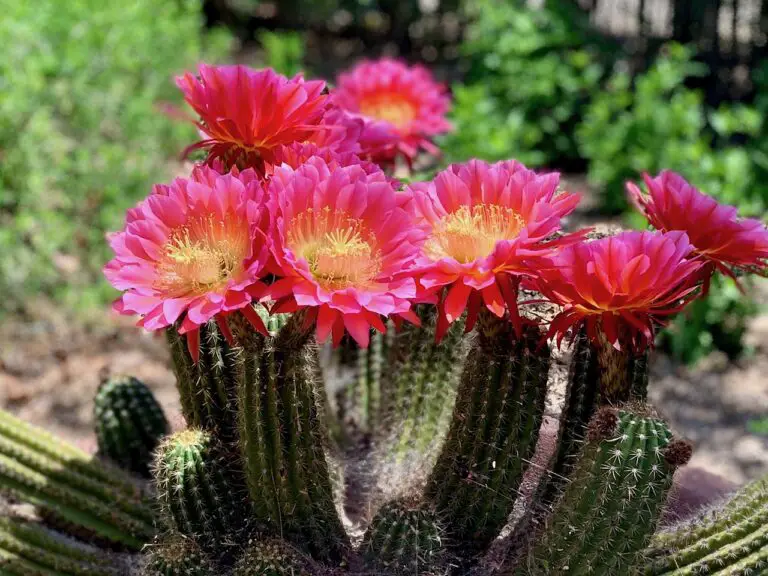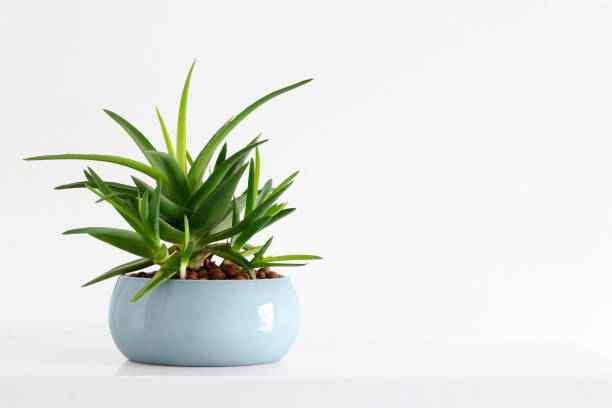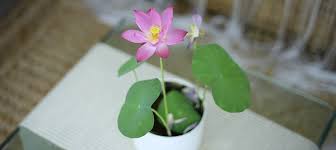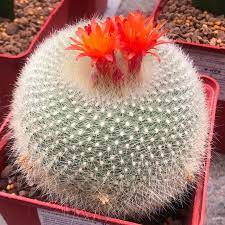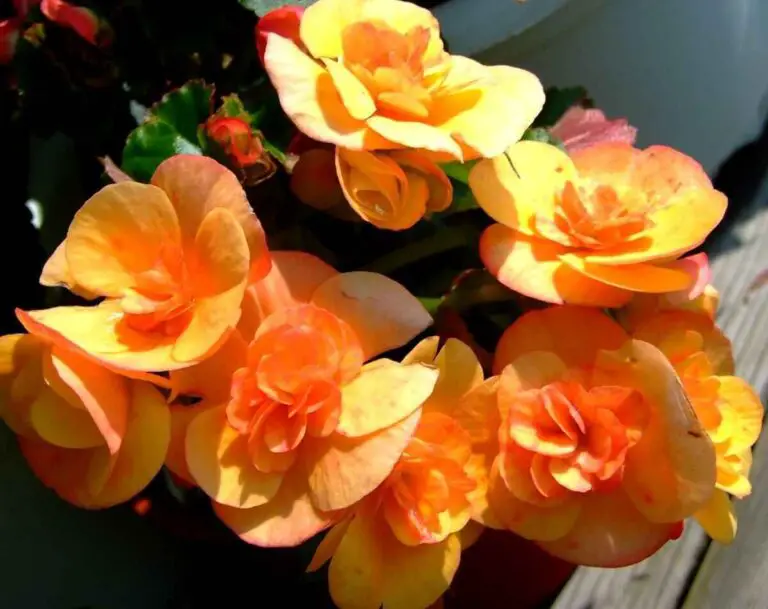Introduction
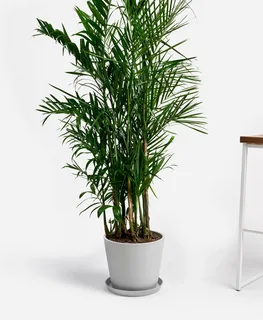
In this article, you’ll learn essential tips to ensure your Bamboo Palm thrives. We’ll cover proper watering techniques and ideal light conditions for a vibrant and flourishing plant. Whether you’re a seasoned plant lover or a beginner, mastering these strategies will guarantee a healthy Bamboo Palm in your home or garden.
Bamboo Palm Overview
| Feature | Description |
|---|---|
| Botanical Name | Chamaedorea (various species) |
| Nicknames | Parlor Palm, Bamboo Palm |
| Light | Low to moderate indirect light |
| Water | Moist but well-draining soil, avoid overwatering |
| Temperature | Warm temperatures (65-80°F) |
| Humidity | Prefers high humidity, tolerates average household levels |
| Size | Indoors: 3-6 ft tall, Outdoors (Zones 10-11): Up to 20 ft tall |
| Toxicity | Pet-friendly |
| Benefits | Air-purifying, low-maintenance |
Understanding the Bamboo Palm
Bamboo Palms, also known as Chamaedorea seifrizii, are enjoyable plants known for their slender, bamboo-like stems and lush, feathery foliage. These plants are native to the rainforests of Central and South America, where they thrive in warm, humid conditions.
One of the key characteristics of Bamboo Palms is their ability to adapt to various light levels, making them suitable for both indoor and outdoor environments. They prefer bright, indirect light but can tolerate lower light conditions, making them ideal for spaces with limited natural light.
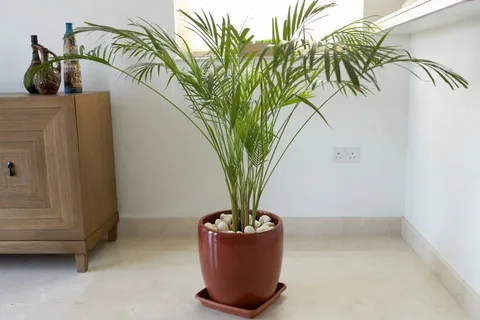
Water your Bamboo Palm thoroughly whenever the top inch of soil feels dry to the touch. Keep the soil consistently moist to keep the plant healthy, but avoid overwatering to prevent root rot.
In terms of soil, Bamboo Palms thrive in well-draining, slightly acidic soil mixes. A blend of peat moss, perlite, and sand provides the ideal growing medium, allowing for proper root aeration and moisture retention.
To keep Bamboo Palms healthy and thriving, provide the right light, water, and soil conditions.
Watering Requirements
Watering your Bamboo Palm correctly is essential for its health and vitality. These plants prefer to be kept consistently moist but not waterlogged. Here are some simple watering tips to keep your Bamboo Palm happy:
- Consistency is Key: Aim to water your Bamboo Palm regularly, allowing the soil to dry out slightly between waterings. Check the moisture level by feeling the top inch of soil with your finger. If it feels dry, it’s time to water.
- Avoid Overwatering: While Bamboo Palms like moisture, they don’t appreciate being constantly soaked. Overwatering can lead to root rot and other issues. Make sure excess water can drain away freely from the pot to prevent waterlogged soil.
- Use Room Temperature Water: When watering your Bamboo Palm, use room temperature water to avoid shocking the plant’s roots. Cold water straight from the tap can stress the plant, so let it sit for a while to reach room temperature before watering.
- Consider Humidity Levels: Bamboo Palms prefer humid environments, so if you live in a dry climate or have low indoor humidity, consider using a humidifier or placing a tray of water near the plant to increase moisture levels.
- Adjust Watering Based on Season: During the warmer months when Bamboo Palms are actively growing, they may require more frequent watering. In the winter months, when growth slows down, you can reduce the frequency of watering to prevent waterlogged soil.
By following these simple watering tips, you can ensure that your Bamboo Palm remains healthy and happy, bringing a touch of tropical beauty to your home or garden.
Light and Location
Finding the right spot for your Bamboo Palm is crucial for its well-being. These plants are like Goldilocks—they prefer their light not too bright, not too dim, but just right. Here’s what you need to know:
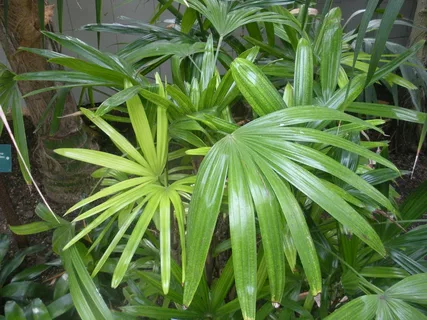
- Bright Indirect Light: Bamboo Palms thrive in bright, indirect light. Think of a sunny day with filtered sunlight streaming through curtains. Place your plant near a window where it can enjoy plenty of natural light without direct exposure to harsh sun rays.
- Avoid Direct Sunlight: While Bamboo Palms love light, they don’t want it shining directly on them. Direct sunlight can scorch their delicate leaves, causing them to turn yellow or brown. If you notice your plant getting too much sun, simply move it to a shadier spot.
- Low-Light Tolerance: One of the fantastic things about Bamboo Palms is their ability to tolerate lower light conditions. If you have a room with less natural light, fear not—your Bamboo Palm will still thrive, albeit at a slightly slower pace.
- Rotate Occasionally: To ensure your Bamboo Palm grows evenly and doesn’t lean towards the light, consider rotating it occasionally. This simple step helps promote balanced growth and keeps your plant looking its best.
Remember, finding the perfect balance of light and location is key to keeping your Bamboo Palm healthy and happy. With a little bit of attention to its lighting needs, your plant will flourish and bring a touch of tropical beauty to your space.
Soil and Fertilization
Just like you need a comfy bed to sleep well, your Bamboo Palm needs the right soil to grow happily. Let’s dive into what makes the perfect bedding for your green friend:
- Well-Draining Soil: Bamboo Palms prefer soil that drains well, meaning it doesn’t hold onto water for too long. A mix of peat moss, perlite, and sand creates the perfect blend, allowing excess water to escape while still retaining enough moisture for the plant’s roots.
- Slightly Acidic pH: While Bamboo Palms aren’t too picky about soil acidity, they do best in slightly acidic conditions. Aim for a pH level between 6.0 and 7.0 to keep your plant thriving.
- Fertilize with Care: Like a balanced diet for you, Bamboo Palms appreciate regular feeding with the right nutrients. Use a balanced liquid fertilizer diluted to half-strength during the growing season (spring and summer) to keep your plant well-nourished.
- Feed Sparingly in Winter: In the cooler months when growth slows down, cut back on fertilization. Your Bamboo Palm needs less food during this time, so feed it sparingly to avoid overfeeding.
By providing your Bamboo Palm with the right soil and occasional feeding, you’ll set it up for success and ensure it grows strong and healthy. Think of it as giving your plant a comfy bed and a nutritious meal—it’ll thank you with lush, vibrant growth.
Temperature and Humidity
Creating a cozy environment for your Bamboo Palm is essential for its well-being. Let’s talk about how to keep your plant comfortable:
- Warmth is Key: Bamboo Palms thrive in temperatures between 65°F and 80°F (18°C to 27°C). They’re like Goldilocks—they don’t want it too hot or too cold, but just right. Keep your plant away from drafts and extreme temperature fluctuations to prevent stress.
- Humidity Matters: These tropical beauties love humidity, just like a spa day for you. If you live in a dry climate or have central heating that dries out the air, consider increasing humidity levels around your Bamboo Palm. You can do this by misting the leaves regularly or placing a humidifier nearby.
- Protect from Cold Drafts: While Bamboo Palms enjoy warmth, they’re not fans of cold drafts. Keep them away from drafty windows or doors during the winter months to prevent chilling their roots and causing damage.
- Watch for Signs of Stress: Your Bamboo Palm will let you know if it’s not happy with the temperature or humidity levels. Look out for yellowing leaves, which can indicate too much heat or too little moisture. Adjusting the environment accordingly can help your plant thrive.
By providing your Bamboo Palm with the right temperature and humidity levels, you’ll create a cozy haven where it can flourish. Think of it as creating a little slice of paradise in your home—one that both you and your plant will enjoy.
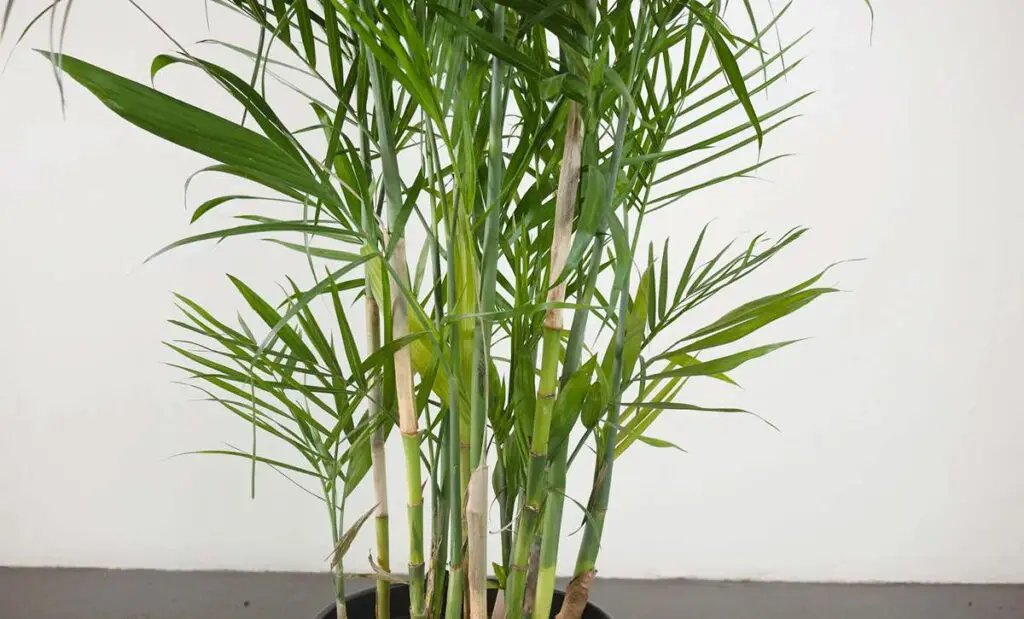
Pruning and Maintenance
Just like a haircut keeps you looking sharp, pruning helps your Bamboo Palm stay in top shape. Here’s how to give your plant a little grooming:
- Remove Dead or Yellowing Leaves: As your Bamboo Palm grows, older leaves may turn yellow or brown. Simply trim them off at the base using clean, sharp scissors or pruning shears. This not only tidies up the plant but also promotes new growth.
- Trim Leggy Stems: If your Bamboo Palm starts to get leggy or sparse in certain areas, don’t be afraid to give it a trim. Prune back any overgrown stems to encourage bushier growth and maintain a balanced appearance.
- Clean the Leaves: Dust can accumulate on your Bamboo Palm’s leaves, hindering its ability to photosynthesize. Wipe the leaves gently with a damp cloth or sponge to remove dust and keep them healthy.
- Inspect for Pests and Diseases: Regular maintenance includes checking for pests and diseases. Inspect the leaves and stems for any signs and treat them promptly to prevent further damage.
By incorporating regular pruning and maintenance into your routine, you’ll help your Bamboo Palm stay looking its best and thriving in its environment. It’s like giving your plant a little spa day—it’ll thank you with lush, vibrant growth.
Pest and Disease Management
Nobody likes uninvited guests, especially when they’re pests or diseases on your beloved Bamboo Palm. Here’s how to keep them at bay:
- Keep an Eye Out: Regularly inspect your Bamboo Palm for any signs of trouble. Look for unusual spots on the leaves, sticky residue, or tiny bugs crawling around. Early detection is key to preventing pests and diseases from spreading.
- Tackle Pests Naturally: If you spot pests like spider mites or mealybugs on your plant, don’t panic. You can often control them with natural remedies like spraying the leaves with a mixture of water and mild soap or wiping them off with a cotton swab dipped in rubbing alcohol.
- Fungus Among Us: Fungal diseases like root rot can spell trouble for your Bamboo Palm. To prevent them, avoid overwatering and ensure proper drainage. If you suspect your plant has a fungal infection, trim away affected areas and treat the soil with a fungicide.
- Quarantine New Additions: If you’re bringing home a new plant or introducing one to your Bamboo Palm’s environment, give it a quarantine period. This helps prevent the spread of any pests or diseases it may be carrying before they can infect your other plants.
By staying vigilant and taking proactive measures, you can keep your Bamboo Palm healthy and happy, free from the pesky pests and diseases that can wreak havoc on its well-being. Think of it as giving your plant a protective shield—it’ll thank you with lush, vibrant growth.
Propagation
Want to multiply your Bamboo Palm family? It’s easier than you think! Here’s how to propagate your plant like a pro:
- Division: To propagate a Bamboo Palm, remove it from the pot and gently divide the root ball into sections with both roots and stems. Repot the divisions in well-draining soil for new baby Bamboo Palms.
- Seeds: Soak Bamboo Palm seeds in warm water for 24 hours, then plant them in moist soil and keep them consistently warm and moist. Wait for the tiny seedlings to sprout up.
- Patience is Key: Whether you’re propagating by division or seeds, remember that patience is key. It may take some time for new plants to establish themselves and start growing, so be patient and give them the care and attention they need.
By mastering the art of propagation, you can expand your Bamboo Palm collection and share the joy of these beautiful plants with friends and family. Plus, there’s nothing quite as satisfying as watching your plant family grow and thrive before your eyes.
Troubleshooting
Running into some hiccups with your Bamboo Palm? Don’t worry, we’ve got you covered! Here’s how to troubleshoot common issues and get your plant back on track:
- Yellowing Leaves: Yellow leaves on your Bamboo Palm may indicate overwatering, underwatering, or poor lighting. Check soil moisture, adjust the watering schedule, and move the plant to a brighter spot if needed.
- Brown Tips: Brown tips on leaves could mean dry air or inconsistent watering. Increase humidity by misting or placing a tray of water nearby. Water the Bamboo Palm regularly to prevent dryness.
- Leggy Growth: If your Bamboo Palm starts to look leggy or sparse, it may need more light. Move it to a brighter location with indirect sunlight, and consider rotating it occasionally to ensure all sides receive equal light exposure.
- Pests and Diseases: Keep an eye out for pests like spider mites, mealybugs, or scale insects, as well as fungal diseases like root rot. Treat infestations promptly with natural remedies or insecticidal soap, and trim away any affected areas to prevent further spread.
- Soil Issues: Poor soil drainage can lead to waterlogged roots and other problems. Ensure your Bamboo Palm is planted in a well-draining soil mix and avoid overwatering to prevent soil-related issues.
By troubleshooting and addressing these common issues promptly, you can ensure your Bamboo Palm stays healthy and thriving for years to come. Don’t be afraid to experiment and adjust your care routine as needed—you’ll soon become a pro at keeping your plant happy and flourishing.
Conclusion
Congratulations! You’ve mastered keeping your Bamboo Palm healthy by understanding its basic needs including proper watering, lighting, and soil.
Remember, caring for your Bamboo Palm is a rewarding journey filled with joy and satisfaction. Whether you’re pruning away dead leaves, propagating new plants, or troubleshooting pesky issues, each step brings you closer to creating a thriving oasis in your home or garden.
So keep up the good work, and don’t forget to enjoy the beauty and tranquility your Bamboo Palm brings to your space. With a little love and attention, your plant will continue to flourish and delight for years to come.
Happy gardening!

